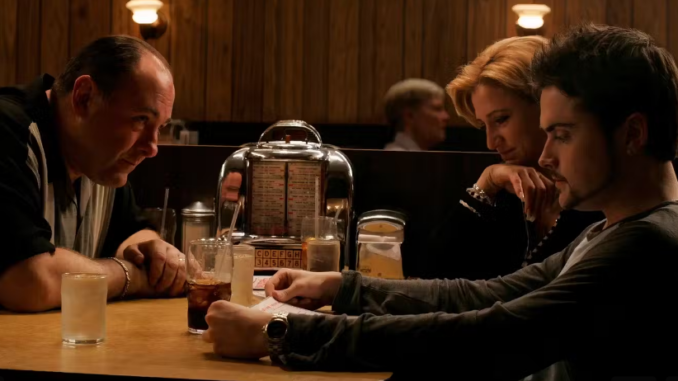
“The Perfect Finale: Why ‘Cut to Black’ Was the Ending Tony Soprano Deserved”
When it came to high-profile television shows in the late ’90s and 2000s, there was nothing quite like HBO’s The Sopranos. This gripping six-season drama followed Tony Soprano (played by the late, great James Gandolfini) as he not only climbed the ranks of the DiMeo crime family, but also had to deal with the escalating problems within his own family. While he was able to deal with most of his internal issues with the help of psychiatrist Dr. Jennifer Melfi (played by actress Lorraine Bracco), maintaining his position as the family’s official street boss was another matter entirely. Coming from rival families vying for the top spot, in addition to those close to him who object to some of his reckless business practices, this tension finally comes to a head in the final episode of the hit TV show.
The ambiguity surrounding the final moments still has fans talking about the show 17 years later. No doubt Tony would be proud of this feat — especially if he knew his death was coming. Like any other season of The Sopranos, a number of smaller events found in “Made In America” (the title of the final episode) foreshadow the kind of conclusion that awaits the audience. On the violent side, we have the assassination of Tony’s greatest enemy, Phil Leotardo. On the mysterious side, there’s the strange cat that stares at both Paulie and Christopher’s painting. While Tony says it just appears during the storm, fans of the show think it’s either Christopher Moltisanti (Tony’s younger cousin) or his girlfriend Adriana La Cerva, reincarnated.
Confusion sets in here too, with Junior in the nursing home not understanding a word of what Tony says about the mafia or where the money meant for Janice’s (Tony’s sister) children is hidden. Finally, a sense of resolution sets in with Tony’s daughter Meadow and her boyfriend Patrick Parisi. Not only is she about to land a great job at a law firm, but the two are also engaged. Violence, mystery, confusion, and resolution all play into the upcoming dinner scene—and those are the same blueprint ingredients that Tony Soprano needed to thrive—no matter what actually happens after the cut to black.
The jukebox on the table is playing Journey’s Don’t Stop Believing. The unnamed couple enjoy each other’s company. The coach with his youth soccer team. The man at the bar eyeing Tony suspiciously. Meadow’s trouble with parking. In just a few seconds, these consecutive shots both relax and push the viewer to the edge of their seats.
The tease of violence, the mysterious signs of disorientation, the confusion about what’s really going on, and the resolution of the whole thing are right at our fingertips. While this particular scene is the only one where the audience isn’t really sure if he’s going to be alive by the end of the film, the combination of the fade to black and these four powerful plot elements contribute to Tony Soprano’s mental survival.
Quietly allowing himself to become such an easy target—and all for the sake of a normal family outing—is Tony’s way of showing the world that he’s not afraid of death. The mystery and confusion on screen combined with the violent resolution off screen is the perfect recipe for Tony’s ego. In a 2021 interview with The Hollywood Reporter, The Sopranos creator David Chase confirmed that killing Tony was always the plan at the end of the series—although the diner setting and the fade-to-black scene weren’t incorporated into those plans until two years before the finale (2005).
Although there was a real-life restaurant that inspired Holsten, Chase has never explained where the fade-to-black scene came from. Could it be that the character of Tony Soprano was so vivid in his mind that his importance overshadowed everything else? Whatever the opposing camp decided on how to craft the ending, the boss of the fictional North Jersey DiMeo crime family seems to have won the argument.
